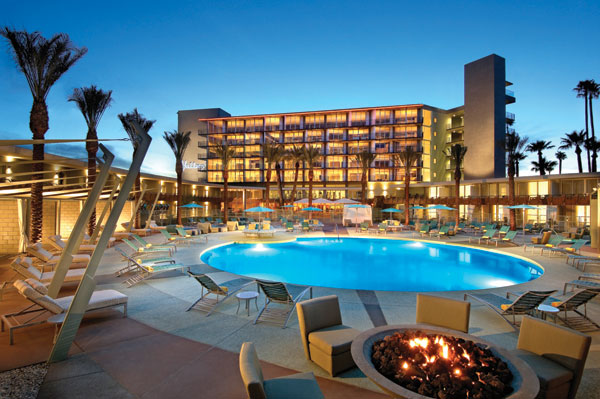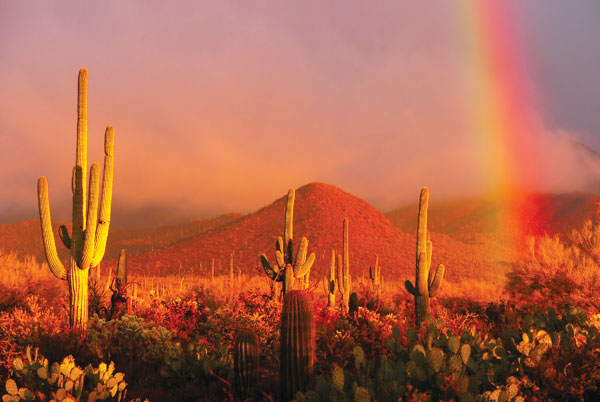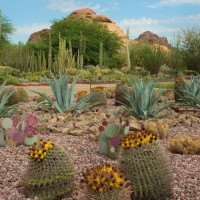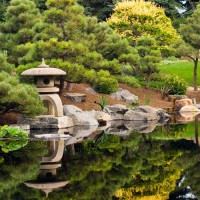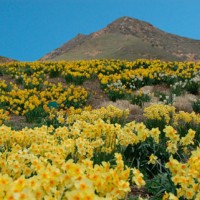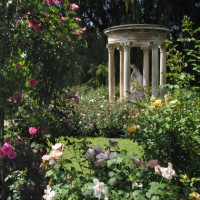Where to Stay, What to See in Arizona
Although the state also has plenty of forest, one way or another, desert stretches from end to end in Arizona. A couple easy ways to enjoy it:
Around Phoenix
Stay near Camelback Mountain: in Scottsdale, that means the beautifully restored Valley Ho, hotelvalleyho.com, which is sort of like walking into the backdrop of a Frank Sinatra movie.
Right in Old Town Scottsdale is the best place to look for desert art: Navajo rugs and Hopi kachinas (ask before you buy, there are a lot of knockoffs) and turquoise jewelry.
A bit more expensive, but right at the foot of Camelback and one of the oldest hotels in Phoenix, the Royal Palms, royalpalmshotel.com, is pure old-style luxury, with incredible views of the mountain.
Either hotel puts you close to Papago Park, Phoenix’s central oasis. On the west side, it’s just park—wander and see what untouched desert is like. On the east side, it’s the zoo and the Desert Botanical Garden, dbg.org, a great place to see how lush the desert really can be.
If that doesn’t satisfy your interest in plants, head out to the
Boyce Thompson Arboretum, ag.arizona.edu/bta, on the edge of the Superstition Mountains.
And by the time you’ve headed out that far, a stop at Lost Dutchman State Park, azstateparks.com/parks/lodu, is the perfect place for a desert hike in the rugged, cliff-strewn mountains. Or take it easier by driving the Apache Trail, which is an old stagecoach road through the mountains. It’ll take all day to get back to town, but, especially in spring when the flowers are blooming, there’s no prettier drive in the state.
Away from Phoenix
Tucson has the Saguaro National Park, some of the most pristine, beautiful desert anywhere, chock full of its namesake cactus. Tucson is also home to the Arizona-Sonora Desert Museum, desertmuseum.org, which is sort of a zoo, sort of a botanical garden, and a great place to see the best of the desert up close. For lodging, go for old and full of character at the downtown Hotel Congress, hotelcongress.com, a local institution since 1919. Or move upscale
and to the outskirts of town with the Westward Look Wyndham Grand, westwardlook.com, which has been around just as long. And at the base of the Santa Catalina Mountains, the swank never gets in the way of the view.
Finally, the most famous patch of desert in Arizona is that big hole in the ground: the Grand Canyon. Not so many cacti—it’s high desert, a completely different kind of ecosystem—but most people are too busy watching the sun light the rim of the canyon like a lava lamp to care about the greenery anyway. Spend the night right at the edge, at the El Tovar, grandcanyonlodges.com/el-tovar-409.html, or head over to Cameron and stay at the Historic Trading Post, camerontradingpost.com. For the record, the much less developed North Rim of the canyon is way prettier than the South, but everybody visits the south side because it’s easier to get to. If you do go to the north side, check the weather: The North Rim closes in winter when there’s too much snow.
High desert or low, the desert rewards the patient: The longer you stay, the more you’ll see, and the richer you’ll find the landscape.
America’s Best Botanical Gardens, Part 1: The West
Click here to see the photo gallery.
| Desert Botanical Garden (Arizona) On the list of cool places to have a botanical garden, the Sonora Desert is near the top. The natural appeal of the setting, combined with the fact that it is among the finest specialized gardens in the world, makes the Desert Botanical Garden special.This 145-acre garden boasts one of the biggest collections of desert plants anywhere. Dedicated to showcasing, researching, and conserving desert flora, the Garden displays over 50,000 plants, including 139 that are rare, endangered, and threatened. Many birds and butterflies also live here, making it alluring to nature lovers of all stripes. Five thematic trails highlight different aspects of the desert: Desert Discovery features international plants; Plants and People of the Sonoran shows how native plants are useful; Harriett K. Maxwell trail is dedicated to desert wildflowers; Steele Herb Garden exhibits desert herbs; and Sonoran Desert Nature emphasizes the relationship of plants and animals. |
| Denver Botanic Gardens (Colorado) The Denver Botanic Gardens strayed from the path of conventional gardens when it opened in the 50s. Instead of bringing in exotic plants, which people were beginning to realize could turn into devastating invasive species, it focused on native plants and environmental responsibility, making it among the first gardens in America to do so.Today, DBG has spread to three locations: Mount Goliath, Chatfield, and the original Denver location. All three offer unique and exciting possibilities. Mt. Goliath blends cultivated wildflowers with the natural appeal of the Rockies. Trails, wildlife, and more await at Chatfield. The central location is just 10 minutes from downtown Denver, making it highly accessible to urban gardeners. All are models of drought tolerance and climatically appropriate gardening. |
| Red Butte Garden (Utah) At almost 100 acres, Red Butte Garden (RBG) is the largest botanical garden in the Intermountain West. It is appropriately named, as it sits at the mouth of Red Butte Canyon, and it’s steep mesas rise to create the most spectacular decorative rocks that one might ever find in a garden.RBG is a center for horticulture and learning. Some guests come for the advice, classes, and workshops, while others come simply for the sights. And there are plenty—floral and art exhibits, concerts, festivals, tons of trails and more. A great reason to visit RBG is the biannual plant sale, where guests can buy a diverse variety of native Utah plants. |
| Huntington Botanical Gardens (California) Due to the vision of financial entrepreneur Henry Huntington, Southern California is home to one of the best cultural centers in the country. His former estate (called The Huntington) houses an expansive collection of rare books, manuscripts and art. It attracts scholars from all over and provides educational programs to 12,000 students a year, but perhaps the greatest legacy of the railroad tycoon is the land on which his estate sits.Known as the Huntington Botanical Gardens, these grounds are a 200-acre wonderland of over 14,000 different plant species. The different thematic gardens, which range from Lily Ponds to Desert, create so many facets to this place that visitors experience something new every visit—even if they’ve come for years. Something is in bloom year-round in this warm-weather locale, which was originally a working ranch. |
